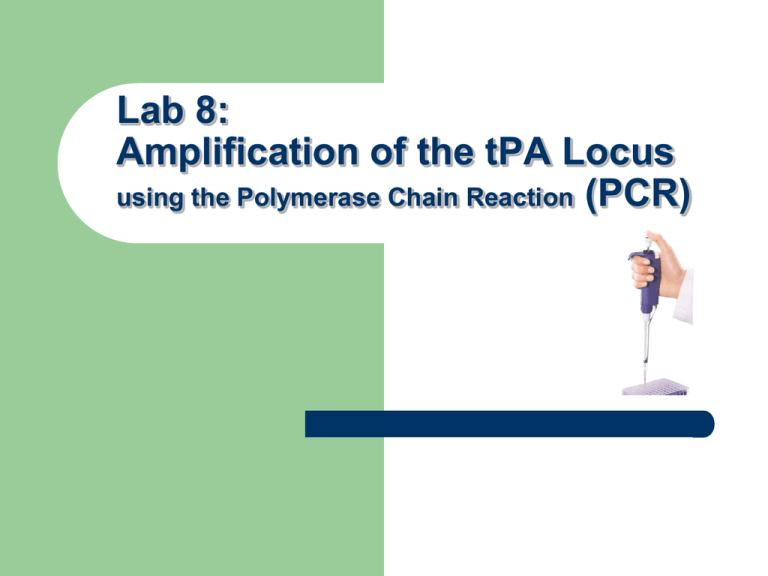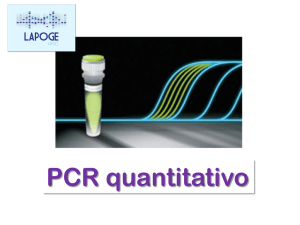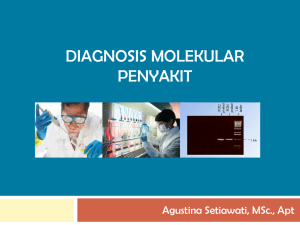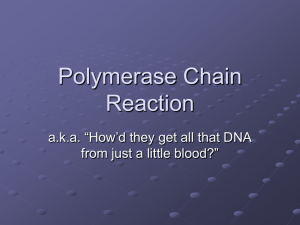Amgen Lab 8
advertisement

Lab 8: Amplification of the tPA Locus using the Polymerase Chain Reaction (PCR) Pre Lab Readiness • Genetics is the study of heredity: How biological information is transferred from one generation to the next as well as how that information is expressed within an organism. • DNA Replication is the process of making an identical copy of a section of (double-stranded) DNA, using existing DNA as a template for the synthesis of new DNA strands. In humans and other eukaryotes, replication occurs in the cell nucleus. • Genes are units of information about specific traits. They are passed from parents to offspring. Each gene has a specific location on a chromosome. • Genotype is the genetic constitution (the genome) of an individual or an organism. Pre Lab Readiness (continued) • Phenotype is the observable physical or biochemical characteristics of an individual or organism. • Alleles are alternative forms of a gene. If two alleles of a pair are the same, it is a homozygous condition. If the two alleles are different, this is called a heterozygous condition. • Polymerase Chain Reaction (PCR) is an in vitro process that yields millions of copies of desired DNA through repeated cycling of a reaction involving the DNA polymerase enzyme. • Thermalcycler is a laboratory apparatus used to amplify segments of DNA via the polymerase chain reaction (PCR) process. The device has a thermal block with holes where tubes holding the PCR reaction mixtures can be inserted. The cycler then raises and lowers the temperature of the block in discrete, preprogrammed steps. Why are we doing this? To use a very powerful technique to amplify buccal cell DNA and determine student genotypes! Lab 8 terms • Buccal Cells are cells from the inner cheek lining. • Chelex beads bind divalent magnesium ions (Mg++) which serve as cofactors for nucleases that will degrade DNA. • Nuclease a family of enzymes that will degrade nucleic acids (DNA). • Amplification an increase in the number of copies of a specific DNA fragment. • Intron segment of a gene that does not code for protein. Introns are transcribed into mRNA but are removed before being translated into protein. • Exon segment of a gene that encodes regions of protein Obtaining your DNA Sample 1. 2. 3. 4. 5. 6. 7. Obtain numbered chelex tube (record the number in your notebook) Use a sterile pipette tip to scrap the inside of both cheeks Add cheek cells to Chelex tube Boil for 10 minutes (lyse cells and destroy nuclease) Centrifuge for 5 minutes at ~10,000 rpm Obtain a PCR tube. Label top and side with the number on chelex tube Transfer 5uL of DNA to PCR tube. AVOID chelex beads! What is PCR? • PCR is a an extraordinarily powerful technique used to amplify a small sample of DNA by repeated cycles of denaturing and replication to an amount large enough to visualize. Visualization of the sample is generally achieved by ethidium bromide staining using agarose gel electrophoresis. The PCR technique was invented by Dr. Kary Mullis in 1983. He was awarded the Nobel Prize in Chemistry in 1993. How and Where is PCR used? • PCR is commonly used to produce many copies of a selected gene segment or locus of DNA. • In criminal forensics, PCR is used to amplify DNA evidence from small samples that may have been left at a crime scene. • PCR can be used to amplify DNA for genetic disease screening. ? How Does PCR Work The PCR process usually consists of a series of twenty to thirty-five cycles. Each cycle consists of three steps. Step 1: Denaturing temperature is raised to 9496°C to break hydrogen bonds Step 2: Annealing temperature is lowered to 56°C to allow primers to attach to the target sequence Step 3: Elongation or Extension temperature is Raised 72°C Taq polymerase binds and adds nucleotides to build new DNA strands Building new DNA Fragments PCR : What do we need? Template DNA – Which contains the DNA fragment to be amplified Primers – are 2 short single stranded polynucleotides that flank the sequence to be amplified Forward Reverse Nucleotides – the building blocks for new DNA strands dATP, dCTP, dGTP, dTTP Magnesium chloride - enzyme cofactor helps Taq Polymerase work efficiently Buffer – a solution which maintains the pH and provides a suitable chemical environment for PCR Taq DNA polymerase is a temperature resistant enzyme which builds DNA strands. Taq was isolated from the bacterium Thermus aquaticus, which normally lives in hot springs in temperatures around 100° C. Taq is stable under the extreme temperature conditions of PCR. What do we use? Genomic DNA sample (5 µL) Master mix (20 µL/reaction): *2.5 µL 10x PCR buffer w/o MgCl2 OR 3.25 µL 10x PCR buffer w/ MgCl2 0.5 µL dNTP’s (10 mM) 2.5 µL Forward primer (4pM/ µL) 2.5 µL Reverse primer (4pM/ µL) 0.15 µL Taq polymerase 11.1 µL ddH2O *Note: if you are using 10x PCR buffer w/o MgCl2, you will need to add 0.75 µL MgCl2 (50 mM) Chromosome 8 The region we will be amplifying is located in an intron (non translated region), of the tPA gene located on Chromosome 8. Chromosome 8 and the tPA Gene • The diagram indicates the intron we will be targeting for PCR. • The intron that we will be targeting for amplification is dimorphic, which means the locus has two forms. • one form carries a 300 bp DNA fragmentknown as an Alu element • the second form of the locus does not carry this fragment. The tPA Gene • The locus (ALU) we will amplify is located in the tissue Plasminogen Activator (tPA) gene. • This gene is on chromosome 8. • The gene codes for a protein that is involved with dissolving blood clots. • tPA is a protein given to heart attack victims to reduce the incidence of strokes. What are ALU elements? • Alu elements are short, around 300 bp, DNA fragments that are distributed throughout our genome. • Estimated that we may carry over 1,000,000 copies of this fragment. Possible Genotypes and Expected Results: 1. Marker 2. Homozygous Alu + (400bp sequence) 3. Homozygous Alu – (100bp sequence) 4. Heterozygous (400bp sequence and 100bp sequence) Loading and Running Gels • Carefully remove comb from gel, put dams down on both ends of the gel tray. • Place gel tray into gel box with buffer ensuring that the wells are closest to the black electrode! • Add 4ul of orange G (loading dye) to your PCR sample and load 20ul of your sample into one of the wells. • Once everyone has loaded their sample plug red electrode to red and black electrode to black on power supply. Be sure the power on the power supply is turned OFF before connecting electrodes! • Adjust voltage to 135-160 volts and allow gel to run for about 15-30 minutes. Loading and Running Gels continued • After gel run is complete, turn off power supply and unplug electrodes • Your gel is now ready to be stained and photographed • Answer questions at the end of Lab 8 Gel Loading Techniques Gel Loading Techniques











